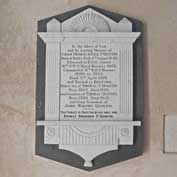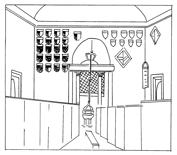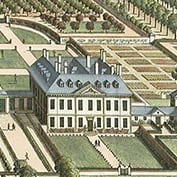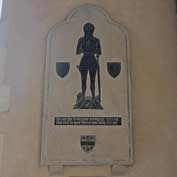By Ishbel Beatty, writing in 1996

The Quintin family memorial in Hatley St George church. Thomas St. Quintin met General Sir John St. George there in August 1861.
Two gentlemen met one another for the first time in Hatley St George on 31st August 1861. Both came from families which had an influence on the village and make it worth our while to consider some aspects of their meeting. Who were they and how did this encounter come about?
Thomas St. Quintin, then living at ‘The Mansion House’, Hatley Park, may have been brought the news by a servant of visitors at the church on that August afternoon. He walked over to see who had occupied the carriage that brought them there.
His father, Thomas Quintin, had left London to become an estate proprietor in Little Gransden and then in Hatley. He came from a Yorkshire family and had made money in London as a glass manufacturer. He named one son William Saint Quintin, and then adopted the ‘St.’ for the rest of the family.
The second Thomas must thus have been gratified to find that he could meet on almost equal terms of name with the visitor, General Sir John St. George, a descendant of the family which had given its name to Hatley but had left there in the 17th century.
Sir John had brought his wife to visit the locality where ten or more generations of his ancestors had once lived. They travelled from Cambridge in a horse-drawn carriage along a turnpiked road with a slow drag up first, Orwell Hill, then a steeper climb at Croydon Hill.
The journey took them, he notes in his account, one hour and 25 minutes. They visited the Rector and obtained the key to the church and had a look at the Parish Register.
The Rector was himself a brother of Thomas St. Quintin. He lived at the Rectory for some years with a series of housekeepers, finally marrying the last one and moving to Broadstairs for his retirement.

The sketch of the interior of Hatley St George church made by the wife of General Sir John St. George in 1861.
So Sir John and his wife entered the church. They found the interior plastered and whitewashed, the chancel wainscoated (that is, panelled with wood).
Surprisingly to modern tastes, the woodwork in the church, including the pews and doors, were painted in a light blue; so also were the pillars which support the arch at the tower.
There against the west wall of the nave were fixed the 21 armorial shields of the St. George family, and in the middle of the chancel was the 15th century brass memorial of Sir Baldwin St. George, which today hangs on the wall. Lady St. George made a drawing of this figure immediately. She may have been aware that it had been damaged in earlier centuries and was restored in 1690.
Then Mr Thomas St. Quintin appeared on the scene to greet the visitors and to invite them to come and see his house. He showed them an old picture of the mansion as it had been before rebuilding of 1783. Old as it was, it did not hark back to the day of the St. Georges, who must have lived in an earlier building on the same site, where a house had been built for Sir Henry St. George in 1640.

The 1707 engraving of Hatley Park from Kip’s Britannia Illustrara. Is it the ‘old picture’ Thomas St. Quintin showed General Sir John St. George?
The present house was described as large and commodious, built of red brick, with stone copings, two stories high, with six windows on the ground floor. There was an avenue of old walnut trees up to the house and ‘numerous avenues’ of elm and other trees in the grounds.
Behind the house were formal gardens, with a moat at the bottom and along one side, which Mr St. Quintin spoke of having filled up. Like many moats in the Hatley villages, this was probably a decorative, rather than defensive moat.
What kind of summer were they having that year, I wonder? Had the moat dried up and did it serve no drainage purpose? And who else was in the household then?
Thomas St. Quintin had a family of 13 children, ranging in age from 27 to nine years at this time, with one son making his career in the Army in India. His wife was Louisa, a daughter of the Astells at nearby Woodbury.

The Baldwin St George brass in Hatley St George church which Lady St. George sketched in August 1861.
Mr St. Quintin may have shown Sir John the new cottages he had had built in the village and the New George Inn. This still stands today, a private house, with the initials T S Q and the date 1850 inscribed on it. We might wish that Sir John had told us more of his visit in his short account, which exists among family papers, but, brief as it is, it provides us with a glimpse of earlier times in this ancient village.
The church now holds a number of memorials to the St. Quintin family and we can still see the St. George shield in the church and the brass memorial of Sir Baldwin which Lady St. George sketched on that summer day.
Gamlingay Gazette, October 1996
Dear Madam,
A Victorian encounter revisited
Following my pieces about Hatley St George in the October Gazette, I have now received a copy of Lady St.George’s sketch of the inside of the church on that occasion, which is reproduced here. Her husband wrote: ‘All the pews, doors and pillars of the tower are wood, painted light blue. The chancel is panelled, and painted the same light blue…’
Dear Madam,
October’s Gazette – article about Thomas Quntin.
Thought you might be interested to learn that some thirty years ago my then husband and I purchased a plot of land in Little Gransden, it had been a public house at some time. The charming cottage on the land was in a ruinous condition so we elected to knock it down and build further back, across the stream.
lt had been our intention to call the house, when built, after the stream that ran through the grounds. However, on finding it was called ‘Public Drain No.3’, we decided instead to name it after a former owner. In the event, we combined the first owner we could find – Thomas Quintin – and the last – Jack Darlow. The house was named Quintin Darlow. Lovely plot, splendid name – diabolical house! I pass it frequently and it is still an eyesore. I always feel very guilty I allowed my husband to erect such an unsympathetic building. Apologies to the present owners.
Yours sincerely
Heather Fyson
Murfitt Way
Gamlingay Gazette, December 1996
Postscript from Ishbel Beatty: I sent this lady a copy of the portrait of Thomas Quintin and she left a message on the answer-phone that he looked just like her late husband. She was about to move to Scotland so we had no further contact.
Re-published on the original Hatley website, May 2006; with minor changes for this website, October 2018; mini-update 17th June 2022.

